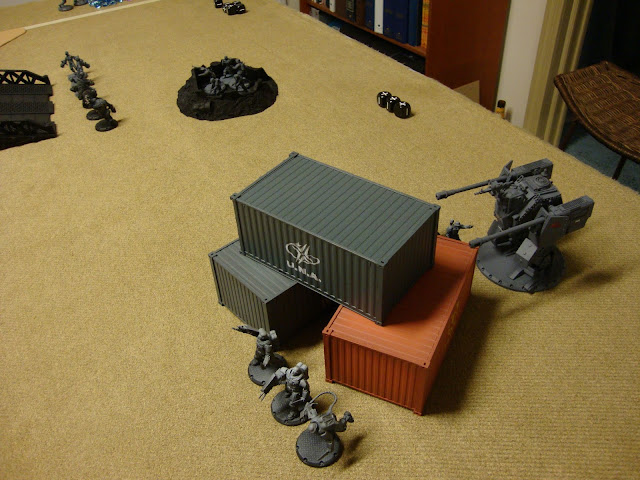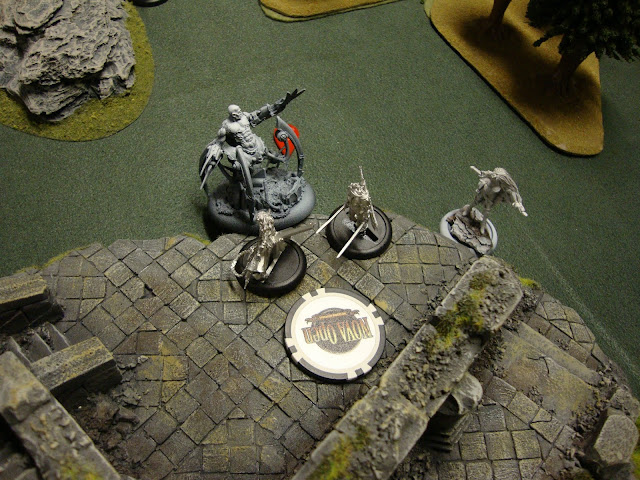A rainy, Sunday afternoon -- a good time to fiddle about with airbrushing and figure out how I'm going to set up, organize, and learn this new skill. I struggled for a few weeks deciding
where to set this up. Ideally, I wanted a permanent station, but that's just not in the cards quite yet. I need to either give away or sell my unused keyboard to make room for a dedicated station, or I need to feel confident enough with controlling the airbrush that I can set it up in the office/studio with the rest of the hobby stuff. Neither of these options are viable soon enough, so I'm setting up a semi-permanent station in the basement, like so.....
I try out two different airbrushes on a relatively safe exercise -- priming. I want to learn how the different airbrushes behave -- their spray patterns, the effects of varying the air pressure, how they clean, etc. I want to learn what supporting equipment and supplies I need (or don't need!) to make the process efficient and enjoyable.
I learn that I actually have decent control of the overspray, even when using a sub-optimal airbrush. I learn that two of my airbrushes are sub-optimal! Obviously, there's newbie error involved, but it's all relative. More on that later.
Priming with an airbrush is amazingly convenient and cost-effective. Sure, there's a significant up-front investment in equipment, but when you can coat multiple models with just a few drops of primer, the equipment will pay for itself very quickly. Plus, I am no longer a slave to the weather. No more risk of trashing miniatures with spray-primer that turns gritty from the humidity. Plus, I have tremendous control over the placement and thickness of the primer on the model.
I try some zenithal highlighting with gray primer over the black base. These models are going to practically paint themselves!
Here's what I've learned about my airbrushes. I wish I had this kind of insight when I was shopping for airbrushes, so hopefully this is useful to someone out there in blog land (if so, you can thank me by being a Follower on the blog!).
The airbrushes below are shown, from top to bottom, Fail to Win.
First up, a single-action, siphon-feed Badger 200 NH, purchased at Michael's. I purchased this airbrush to learn on. Single action is simpler, and it's probably easier to clean and maintain. I planned to use this on coarse work, like terrain, just to learn the basics of airbrushing and learn how to clean and maintain it. It did serve this purpose, and, indeed, terrain is probably all this brush is good for. I did use it to apply the camo pattern on that Devilfish model, but it was a struggle. I didn't have the fine control I needed. I'll continue to use this for terrain, but the control is inadequate to even do simple priming. I'm sure I could improve the control by twiddling with the air pressure and the limiter, which I attempted to do with the Devilfish, but it's just not worth it when there are better tools, even for a beginner.
This situation is analogous to learning an instrument, say guitar. If you want to learn guitar, don't buy a cheap guitar to "test the waters" to see if it's something you'll stick with. Buy a quality instrument. A poor instrument is hard to learn (hard to fret the strings; hard to keep in tune; etc.), and you just set yourself up for frustration, and you give up. A quality instrument feels good to play -- even if you suck. A quality instrument draws you back to play again -- until you don't suck. Same with airbrushes, I think.
The second airbrush is a dual-action, gravity-feed Thayer & Chandler Omni 4000. This is the airbrush I requested for Christmas after doing a lot of on-line research. Unfortunately, I didn't realize that this brand is, for all practical purposes, out of production. Badger bought it, I think, but it was a real chore trying to find a hose or adapter, just to connect the thing. When I finally purchased parts to enable using the airbrush, I used it as my learning instrument. My learning exercise was to spray terrain, and I probably made two mistakes. One was blowing house latex paint through the airbrush. That's probably OK for the Badger 200 NH, but probably not for the Omni, which has a finer needle. Secondly, I cleaned it using a cleaning kit. I learned from a YouTube video that you shouldn't use the brush cleaning kits, because they'll damage the finely calibrated fit of the needle and other components. That YouTube video was an hour-and-a-half presentation series by the second-generation owner of Badger. Sorry, I don't remember his name -- I came across the video by way of Wargamers Consortium. Anyway, this airbrush has presented a bit of a headache, and it didn't seem to offer any better control than the Badger, possibly because it may have microscopic scratches in the needle housing, due to cleaning it with the cleaning kit.
That brings us to the dual-action, gravity-feed Harder & Steenbeck Ultra 8483. This was the control I was looking for! This is how I imagined airbrushing would feel. Now the downside with this airbrush was that I purchased it with a starter kit of Vallejo Air Color paint. Handy dandy. But I had no idea that the connector is a quick-release coupler. None of my screw-on connectors on my hoses worked, of course, and I had no idea what was supposed to work with it. It was only because the Grex salesperson showed me the quick-release connectors at the NOVA Open that I learned to recognize what this thing is. Luckily, I purchased quick-release adapters from the Grex guy, so I was able to try them out with this airbrush, and they worked. This brush was a pleasure to use and easier to clean than the other ones.
Next up will be my Grex trigger-action brushes. I wanted to get a clue to what I was doing before I risked using my hard-won NOVA Open prizes. I look forward to trying them out, and I have even higher expectations of their performance over the Ultra.
 First off, my copy of CoolMiniOrNot Annual 2011 arrived. Yup, that's the correct year. As a matter of fact, I had to double-check the copies I already owned to make sure I wasn't ordering a duplicate. On top of that, I couldn't remember if I had made it into the book or not. Turns out I did! Twice!
First off, my copy of CoolMiniOrNot Annual 2011 arrived. Yup, that's the correct year. As a matter of fact, I had to double-check the copies I already owned to make sure I wasn't ordering a duplicate. On top of that, I couldn't remember if I had made it into the book or not. Turns out I did! Twice!










































